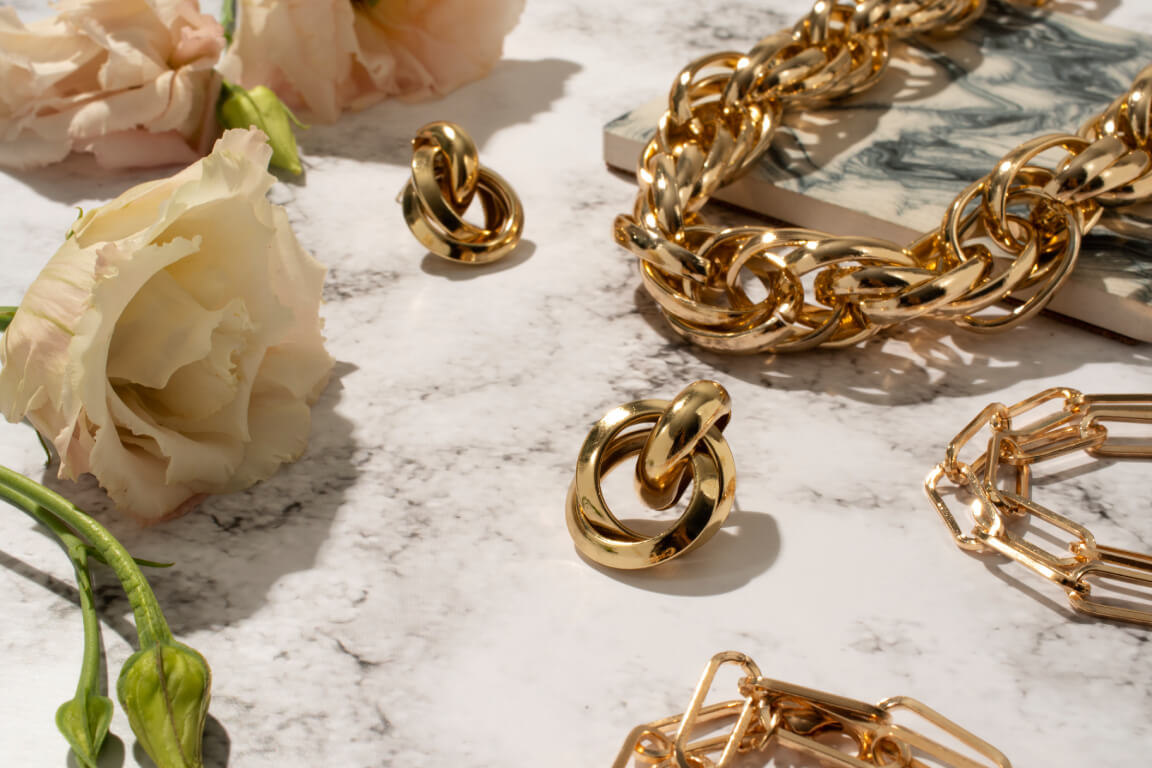What types of gold exist: Detailed guide
Indice
Introduction to types of gold: Symbol of luxury and timeless beauty
Gold has always been a symbol of luxury, prestige and timeless beauty. Used in jewellery, watchmaking and investments, gold continues to be a popular choice for those looking to own a piece of elegance. However, not alltypes of goldare created equal.
With various types of gold available on the market, each with their own unique characteristics, it is important to understand the differences to make an informed choice suited to your needs.
In this guide, we will explore the different types of gold that exist, from traditional yellow, white and rose gold alloys to more modern variations such as black gold and blue gold.
You will discover the specific compositions, distinctive properties and advantages of each type of gold, as well as receiving advice on how to maintain and care for your gold jewelery to ensure its beauty and durability over time.
Whether you are looking for a classic and timeless piece or a unique and modern jewel, this guide will help you navigate through the fascinating and varied world of gold, allowing you to choose with confidence and satisfaction.
Yellow gold
Yellow gold is the most traditional and recognizable form of this precious metal, renowned for its warm, rich luster.
Used since ancient times, yellow gold has a timeless appeal that continues to be appreciated around the world. Its composition consists of a mixture of pure gold with alloys such as copper and zinc, which give the metal greater resistance and durability.
- 24 carats (24K): 99.9% pure gold, extremely soft and less used in jewelry;
- 22 karat (22K): Contains 91.6% gold, more resistant than 24K but still quite soft;
- 18 carats (18K): Composed of 75% gold and 25% alloys, it is ideal for high quality jewelry;
- 14 Karat (14K): Containing 58.5% gold, it is very popular for its durability and affordability.
White gold
White gold is a sophisticated and modern choice. It is created by mixing pure gold with white metals such as palladium, silver or nickel.
It is often plated with rhodium to improve its shine and durability.
Common options include:
- 18K white gold: With 75% pure gold, it is prized for its balance between purity and durability;
- 14K white gold: Contains 58.5% gold and is a popular choice due to its durability and lower cost than 18K white gold.
Rose gold
Rose gold, also known as red gold or rose gold, is prized for its warm, romantic rosy color.
This effect is achieved by mixing pure gold with a larger amount of copper.
Common options include:
- 18K rose gold: Made of 75% gold and a mixture of copper and silver, it is popular for its durability and beauty;
- 14K rose gold: Containing 58.5% gold, it is more durable and affordable than 18K rose gold.
Black gold
Black gold is a distinctive and modern choice. This unique effect is achieved by treating pure gold with metals such as cobalt, black sapphire or rhodium, or by using processes such as oxidation or laser treatment. Black gold is prized for its elegant and sophisticated appearance.
- 18K black gold: With 75% pure gold, it offers a balance between purity and durability;
- 14K black gold: Containing 58.5% gold, it is more resistant and affordable than 18K black gold.
Blue gold
Blue gold is a rare and fascinating option made by combining pure gold with gallium or indium, or by treating the surface of the gold with iron and high heat.
This gives the gold a particular blue hue.
- 18K blue gold: Contains 75% pure gold and offers a distinctive appearance;
- 14K blue gold: With 58.5% gold, it is more durable and affordable than 18K blue gold.
Purple gold
Purple gold is another type of colored gold, created by combining gold with aluminum.
This type of gold is fragile and is often used for decoration rather than jewelry that must withstand daily use.
- 18K purple gold: With 75% pure gold, it is rare and sought after for its unique color.
Green gold
Green gold is a unique and less common choice, made by mixing pure gold with silver and sometimes copper.
This creates a very distinctive greenish hue.
The most common options include 18K and 14K green gold, similar in composition to other types of colored gold.
Yellow gold vs. white gold vs. rose gold
- Yellow Gold: Traditional, hypoallergenic, easy to work and repair;
- White Gold: Modern, often plated with rhodium for added shine, may cause nickel allergies in some people;
- Rose Gold: Romantic, unique, more durable thanks to the copper content.
The importance of carats
The purity of gold is measured in carats. The higher the karat count, the greater the amount of pure gold contained.
However, pure gold is very soft, so adding alloys increases the hardness and durability of the jewelry.
Recycled gold
Recycled gold is an eco-friendly and sustainable option, made by remelting old jewelry, industrial waste and other sources.
This type of gold has the same physical and chemical properties as recently mined gold, but with a reduced environmental impact.
Conclusion
Understanding the different types of gold is essential to making an informed choice and finding the perfect jewel that reflects your style and elegance.
At Cipolla dal 1950 Gioiellieri, we offer an exclusive selection of gold jewelry that embodies timeless beauty and superior quality.
Our commitment to excellence and our long tradition in the sector allow us to offer only the best to our customers, both in our historic showroom in Palermo and through our portal or








